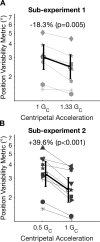Human manual control precision depends on vestibular sensory precision and gravitational magnitude
- PMID: 30379610
- PMCID: PMC6442919
- DOI: 10.1152/jn.00565.2018
Human manual control precision depends on vestibular sensory precision and gravitational magnitude
Abstract
Precise motion control is critical to human survival on Earth and in space. Motion sensation is inherently imprecise, and the functional implications of this imprecision are not well understood. We studied a "vestibular" manual control task in which subjects attempted to keep themselves upright with a rotational hand controller (i.e., joystick) to null out pseudorandom, roll-tilt motion disturbances of their chair in the dark. Our first objective was to study the relationship between intersubject differences in manual control performance and sensory precision, determined by measuring vestibular perceptual thresholds. Our second objective was to examine the influence of altered gravity on manual control performance. Subjects performed the manual control task while supine during short-radius centrifugation, with roll tilts occurring relative to centripetal accelerations of 0.5, 1.0, and 1.33 GC (1 GC = 9.81 m/s2). Roll-tilt vestibular precision was quantified with roll-tilt vestibular direction-recognition perceptual thresholds, the minimum movement that one can reliably distinguish as leftward vs. rightward. A significant intersubject correlation was found between manual control performance (defined as the standard deviation of chair tilt) and thresholds, consistent with sensory imprecision negatively affecting functional precision. Furthermore, compared with 1.0 GC manual control was more precise in 1.33 GC (-18.3%, P = 0.005) and less precise in 0.5 GC (+39.6%, P < 0.001). The decrement in manual control performance observed in 0.5 GC and in subjects with high thresholds suggests potential risk factors for piloting and locomotion, both on Earth and during human exploration missions to the moon (0.16 G) and Mars (0.38 G). NEW & NOTEWORTHY The functional implications of imprecise motion sensation are not well understood. We found a significant correlation between subjects' vestibular perceptual thresholds and performance in a manual control task (using a joystick to keep their chair upright), consistent with sensory imprecision negatively affecting functional precision. Furthermore, using an altered-gravity centrifuge configuration, we found that manual control precision was improved in "hypergravity" and degraded in "hypogravity." These results have potential relevance for postural control, aviation, and spaceflight.
Keywords: human; manual control; otoliths; psychophysics; semicircular canals; thresholds; vestibular perceptual threshold.
Conflict of interest statement
No conflicts of interest, financial or otherwise, are declared by the authors.
Figures





References
-
- Benson AJ, Hutt EC, Brown SF. Thresholds for the perception of whole body angular movement about a vertical axis. Aviat Space Environ Med 60: 205–213, 1989. - PubMed
-
- Benson AJ, Spencer MB, Stott JR. Thresholds for the detection of the direction of whole-body, linear movement in the horizontal plane. Aviat Space Environ Med 57: 1088–1096, 1986. - PubMed
Publication types
MeSH terms
Grants and funding
LinkOut - more resources
Full Text Sources
Miscellaneous

